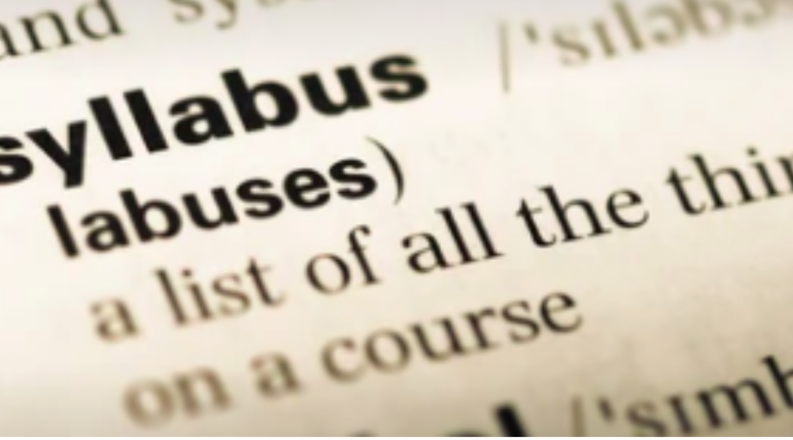Contributing Faculty
Dr. Tomeka Wilcher is the educational program developer for the Center for Faculty Development.
Essential Questions
-
What is a graphic syllabus?
-
How can students benefit from using a graphic syllabus?
-
What should I include in a graphic syllabus?
-
What programs or platforms can I use to create a graphic syllabus?
What is the purpose of the syllabus?
The syllabus is a blueprint for a class. It provides students with a detailed plan or outline of the essential components of the course, as well as the instructor's expectations. It keeps faculty focused and serves as a reference. A syllabus has three purposes: as a contract, a permanent record, and a learning tool. It is a contract because it contains policies of conduct. It is a permanent record because it contains important information about the course (title, dates, credit hours earned, pre- or co-requisites, course description, required texts, objects, professional standards, deadlines, and descriptions of content and assessments). It is a learning tool because it includes tips, campus resources, availability of the instructor, rubrics, and models of high-quality work (Parker & Harris, 2002; Ludy, Brackenbury, Folkins, Peet, & Langendorfer, 2016). In many instances, faculty syllabi take this traditional approach. However, the classroom is evolving into a space where community, innovation, and student engagement are encouraged. Therefore, creating a syllabus that exemplifies enthusiasm for learning, integrates contemporary design features, and incorporates purposeful use of graphics (Ludy, Brackenbury, Folkins, Peet, Langendorfer, 2016, p. 2) could be a viable option and meet the needs of some students' learning styles.
Why use a graphic syllabus?
The graphic syllabus, also known as the engaging syllabus, digital syllabus, or visual syllabus, takes a reader-friendly approach. Creating a graphic syllabus does not mean merely taking elements of the traditional syllabus and adding color and a few graphics. It means creating a visually appealing, interactive document that is essential for students to be successful in the course. The graphic syllabus is like the traditional syllabus, but it communicates friendliness, approachability, and flexibility (Richmond, 2016). It can serve as the only form of the course's syllabus, or it can serve as a supplement (Bowers-Abbott, 2016), especially for students who may find a visually appealing document less intimidating, and easier to read, navigate, and access (Dean & Fornaciari, 2014).
What should be included in the graphic syllabus?
Graphics. Incorporate images that reflect the course or the teaching philosophy; add color to the background or highlight key words and phrases; incorporate tables and charts; and use bullet points instead of long paragraphs.
Table of contents. Place this element at the beginning of the graphic syllabus and provide students with the main components and layout of the syllabus, along with page numbers.
Instructor information. Create a space for the instructor's information. This may include an image, preferred pronouns, contact information, contact hours, and possibly a favorite quote.
Course information. Create a space to provide the course's description, required texts and resources, and meeting dates and times.
Teaching philosophy. Provide brief bullet points that highlight your teaching philosophy. This will give students insight on who will be guiding their learning experience.
Inspirational quotes. Add quotes throughout the graphic syllabus that could motivate students as they work through the course.
Objectives and outcomes. Provide a space that highlights the course's objectives and outcomes.
Course schedule. Provide students with an outline of weekly meetings, topics, assignments, and checkpoints. Checkpoints are built into lengthy projects and give the instructor an opportunity to offer feedback as students revise their work.
Assignments and projects. Create a space to highlight the assignments and projects as well as align each with a learning outcome.
Hyperlinks. Include links to resources that will enhance students' learning experience. These resources can be articles, e-books, videos, audio resources, web pages, etc. Hyperlinks can also be links to longer and more descriptive handouts of the assignments, major projects, and rubrics. Last, instructors can hyperlink all policies that students should be aware of - policies relating to disability accommodations, academics, attendance, and make-ups/revisions.
FAQ section. Compile a list of frequently asked questions that students can reference as the course progresses.
Campus resources. Provide a list of links to campus resources that can provide the support students may need.
Tips and strategies. Provide a list of or a hyperlink to documents of tips and strategies that can help students succeed.
Platforms that can be used to create a graphic syllabus include Microsoft Word, Google Slides, Google Docs, or a template from Canva. Below is a sample of a graphic syllabus, followed by tutorial videos on how to create one:
Sample Graphic Syllabus
Google Docs Tutorial
Google Slides Tutorial
Canva Tutorial
References
- Bowers-Abbott (2020). The straight scoop syllabus. Faculty Focus. https://www.facultyfocus.com/articles/course-design-ideas/the-straight-scoop-syllabus/
- Dean, K.L. & Fornaciari, C.J. (2014). The 21st-century syllabus: Tips for putting andragogy into practice. Journal of Management Education, 38(5), 724-732. https://doi.org/10.1177/1052562913504764
- Ludy, Brackenbury, Folkins, Peet, Langendorfer (2016). Student impressions of syllabus design: Engaging versus contractual syllabus. International Journal for the Scholarship of Teaching and Learning 10(2), 1-23. https://doi.org/10.20429/ijsotl.2016.100206
- Parkes, J. & Harris, M.B. (2002). The purposes of a syllabus. College Teaching 50(20), 55-61. www.jstor.org/stable/27559083
- Richmond, A.S. (2016). Constructing a learner-centered syllabus: One professor's journey. IDEA Paper No. 60. Retrieved from https://www.ideaedu.org/Portals/0/Uploads/Documents/IDEA%20Papers/IDEA%20Papers/PaperIDEA_60.pdf



